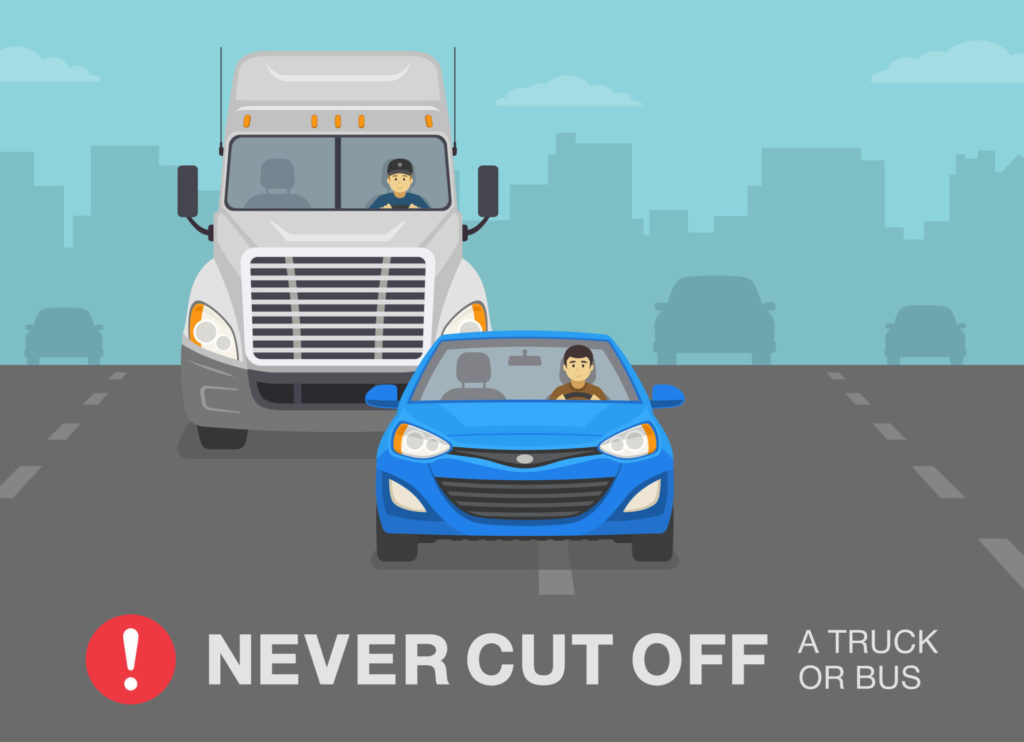The keys to safe driving are wearing your seatbelt, staying focused on the road, paying attention to nearby vehicles, and using your car’s built-in tools to communicate with other drivers or pedestrians. However, it can be easy to develop some not-so-safe habits when you get too comfortable behind the wheel, creating hazards for yourself and others.
Due to their size and weight, semi-trucks especially have a hard time adjusting to the bad driving habits of the drivers around them. Whenever you’re driving near a semi-truck, it is important NOT to exhibit the following problematic habits:
Not Using Your Blinker

Your blinker is there for a reason. It is a mandatory safety feature that allows you to communicate with the drivers around you about your intentions to turn left or right or change lanes.
Blinkers became standard features of vehicles in 1968, and today’s laws state that drivers are required to signify their intentions with their blinkers so that the vehicles behind them or those approaching from the opposite direction can understand their intentions and prepare to make adjustments if necessary.
Why are turning signals necessary for semi-trucks?
Turning signals are important for everyone, but semi-trucks especially benefit from you using your blinker. Semi-trucks are massive machines, the standard 18-wheeler being roughly 72 feet long and weighing about 35,000 pounds (17.5 tons) when empty. With cargo, trucks can weigh up to the limit of 80,000 pounds (40 tons). Compare that to your vehicle, which likely weighs between 1,500 to 5,500 pounds (0.75-2.75 tons).
When someone changes lanes in front of you without using their blinker, it could require you to adjust quickly by applying your brakes or making an unintended lane change yourself. When someone changes lanes in front of a loaded or unloaded semi-truck without warning, the truck driver may have to make similar adjustments but with much more difficulty due to its size and weight. Using your blinker correctly will give the truck driver time to start braking sooner or make other necessary adjustments.
Tailgating
We’ve all driven down the road with someone following way too close for comfort. All it takes is one scenario that requires last-minute braking (like an animal running out in front of you or another car cutting you off), and the following vehicle could crash into your rear bumper (or worse).
Safe driving requires keeping enough distance between yourself and the car in front of you to ensure fender benders or more disastrous crashes do not occur. The three-second rule is the easiest way to determine the right follow distance. When the car in front of you passes a road sign or other distinctive object, you should be able to count three full seconds before you pass the sign or object. That way, if there is braking ahead, you can adjust your speed in time and not at the last second.
Why is tailgating dangerous with semi-trucks?
Tailgating a semi-truck is extremely dangerous, whether on a regular road or a highway. Due to the size of a semi-truck, it is nearly impossible to see the activity occurring in front of it if you are following too closely behind. If vehicles are slowing to a stop, you’ll have no way of knowing or adjusting in a timely manner.
Plus, one of a semi-truck’s blind spots spans 30 feet behind the trailer. When driving within that 30-foot span, the truck driver will have no idea you are there, which can make for a dangerous situation.
Cutting Drivers Off

Cutting someone off on the road requires the other driver and surrounding vehicles to adjust quickly (and probably calm their frustrations). While there are rare occasions where last-minute lane changes in front of another driver may be necessary, it should never be a habit to develop or exhibit.
When you know you must change lanes, do so sooner rather than later, and use your blinker. That will help ensure you are merging safely and are giving the drivers around you time to either slow down for you, speed up to pass you and make room, or change lanes themselves.
Why is it dangerous to cut off a semi-truck?
Cutting anyone off is dangerous, but as mentioned, semi-truck drivers have more mass and weight to account for—fast braking is not easy, nor is changing lanes. When you cut off a semi-truck, the driver must quickly adjust speeds or consider other maneuvers to prevent a dangerous accident.
Plus, the 20-foot span in front of a semi-truck is another blind spot for the driver. When you cut a driver off, you will likely be in that 20-foot span, and the driver will have a difficult time knowing where you are until they can adjust speeds and put enough distance between you and the truck.
If you are ever involved in a semi-truck accident, turn to the expert attorneys at Clark, Smith & Sizemore.
Even safe drivers can find themselves in an accident with a semi-truck. If you have experienced an accident with a semi-truck, our attorneys will thoroughly investigate your case and will fiercely represent you in the fight for justice. Call us today for a free consultation: 478-254-5040
Thank you for checking out part 2 of our 6-part series on semi-truck accidents. Stay tuned for our upcoming articles:
- Safety Tips for Driving Near an 18-Wheeler in a Construction Zone
- Avoid These Moves When Sharing the Highway with a Semi-Truck
- Warning Signs of Erratic Driving: Semi-Truck Edition
- Maximize Road Safety by Recognizing These Semi-Truck Blind Spots
- Can Bad Weather Increase My Chance of a Semi-Truck Accident?
- What to Do if You Experience a Tractor-Trailor Accident
